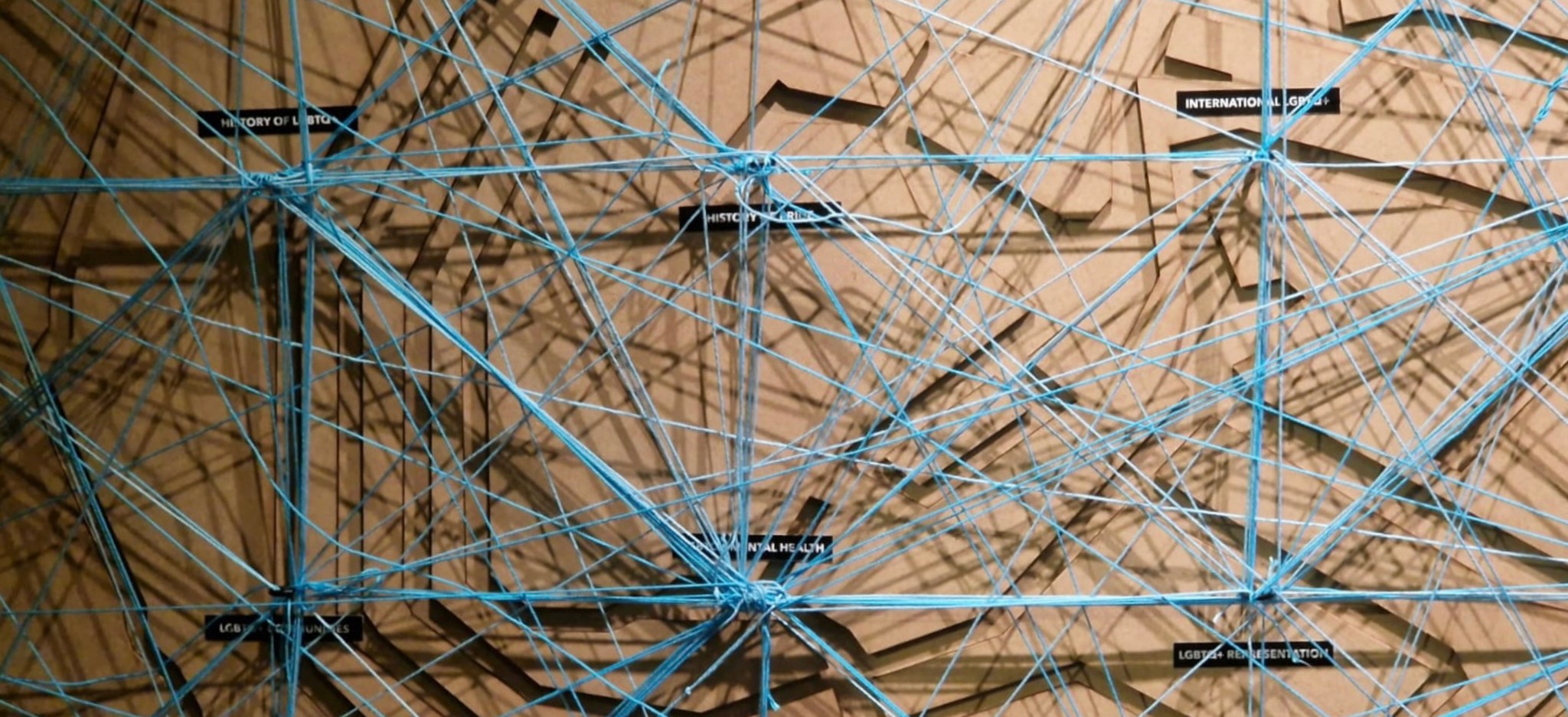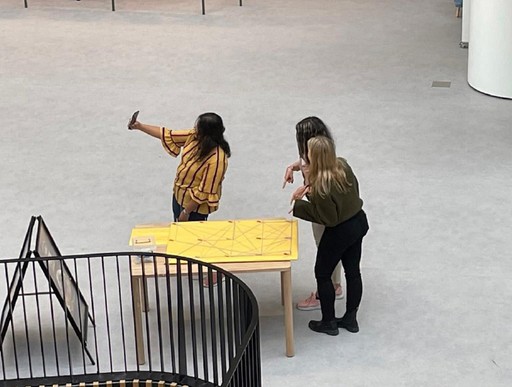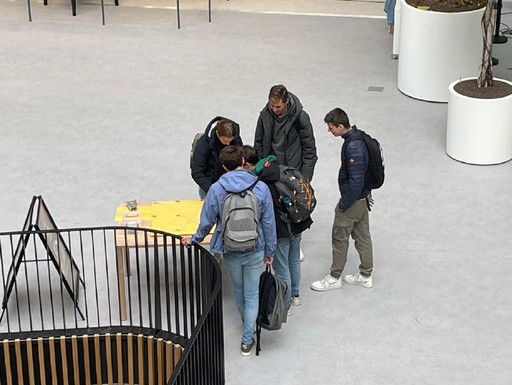INSTALLATION FOR DIVERSITY
INSTALLATION FOR DIVERSITY
INSTALLATION FOR DIVERSITY
CLIENT:
Grachten museum
ROLE:
Design lead
UX Designer
DURATION:
8 Weeks
TARGET AUDIENCE:
Museum visitors attending the Museum nacht event at Grachten museum
PROBLEM STATEMENT:
The Grachtenmuseum specifically wanted to gather opinions on the topic of sexual diversity and LGBTQ+. They wanted to use this data as inspiration for creating a LGBTQ+ exhibition in the Grachtenmuseum. To gather this data, they asked us to create an interactive installation that would be used during the Museumnacht.
PROBLEM STATEMENT:
The Grachtenmuseum specifically wanted to gather opinions on the topic of sexual diversity and LGBTQ+. They wanted to use this data as inspiration for creating a LGBTQ+ exhibition in the Grachtenmuseum. To gather this data, they asked us to create an interactive installation that would be used during the Museumnacht.
CLIENT:
Grachten Museum
ROLE:
Design lead
UX Designer
DURATION:
8 Weeks
TARGET AUDIENCE:
Museum visitors attending the Museum nacht event at Grachten museum
PROBLEM STATEMENT:
The Grachtenmuseum specifically wanted to gather opinions on the topic of sexual diversity and LGBTQ+. They wanted to use this data as inspiration for creating a LGBTQ+ exhibition in the Grachtenmuseum. To gather this data, they asked us to create an interactive installation that would be used during the Museumnacht.
PROJECT'S GOALS:
1.
The project aimed to engage museum visitors through interactive topic selection, enhancing their connection to the upcoming exhibition.
2.
The installation aimed to collect visitor insights on LGBTQ+ and sexual diversity themes, informing exhibition curation to align with diverse audience interests. Through feedback, the project aimed to enhance resonance and relevance.
3.
The project prioritized inclusivity by offering diverse LGBTQ+ topics, aiming to represent a wide range of identities and experiences for an inclusive audience engagement.
4.
The project aimed to educate visitors about LGBTQ+ history, issues, and sexual diversity through engaging and interactive content.
5.
The project also aimed to enhance visibility for the museum's upcoming LGBTQ+ and sexual diversity exhibition. They planned to create an interactive installation to generate anticipation and interest among current and future visitors, building excitement for the exhibition.
PROBLEM STATEMENT:
The Grachtenmuseum specifically wanted to gather opinions on the topic of sexual diversity and LGBTQ+. They wanted to use this data as inspiration for creating a LGBTQ+ exhibition in the Grachtenmuseum. To gather this data, they asked us to create an interactive installation that would be used during the Museumnacht.
PROBLEM STATEMENT:
The Grachtenmuseum specifically wanted to gather opinions on the topic of sexual diversity and LGBTQ+. They wanted to use this data as inspiration for creating a LGBTQ+ exhibition in the Grachtenmuseum. To gather this data, they asked us to create an interactive installation that would be used during the Museumnacht.
PROJECT'S CONCEPT:
Following the conceptualization of our interactive installation, we proceeded with its physical realization. Our inspiration drew heavily from a range of interactive installations, most notably 'WHAT MADE ME' by Dorota Grabkowska and Kuba Kolec. Our installation, however, stood apart by spotlighting Amsterdam's intricate canal network as a central theme. Leveraging the city's map and canals, we conducted user research to curate predetermined topics centered around the LGBTQ+ community and sexual diversity. This allowed visitors to engage actively by dragging threads to indicate their preferences, forging a meaningful link between Amsterdam, the museum of the canals, and the LGBTQ+ community.
PROJECT'S CONCEPT:
Following the conceptualization of our interactive installation, we proceeded with its physical realization. Our inspiration drew heavily from a range of interactive installations, most notably 'WHAT MADE ME' by Dorota Grabkowska and Kuba Kolec. Our installation, however, stood apart by spotlighting Amsterdam's intricate canal network as a central theme. Leveraging the city's map and canals, we conducted user research to curate predetermined topics centered around the LGBTQ+ community and sexual diversity. This allowed visitors to engage actively by dragging threads to indicate their preferences, forging a meaningful link between Amsterdam, the museum of the canals, and the LGBTQ+ community.
PROJECT'S GOALS:
1.
The project aimed to engage museum visitors through interactive topic selection, enhancing their connection to the upcoming exhibition.
2.
The installation aimed to collect visitor insights on LGBTQ+ and sexual diversity themes, informing exhibition curation to align with diverse audience interests. Through feedback, the project aimed to enhance resonance and relevance.
3.
The project prioritized inclusivity by offering diverse LGBTQ+ topics, aiming to represent a wide range of identities and experiences for an inclusive audience engagement. Through varied content, the installation aimed to reflect the diversity within the exhibition.
4.
The project aimed to educate visitors about LGBTQ+ history, issues, and sexual diversity through engaging and interactive content. The installation aimed to foster a deeper understanding and appreciation of these important themes.
5.
The project had the additional goal of boosting the visibility and promotion of the museum's upcoming LGBTQ+ and sexual diversity exhibition. Through the creation of an interactive installation, the museum aimed to spark anticipation and interest among its current audience and prospective visitors, ultimately generating excitement and anticipation for the exhibition.
PROJECT'S GOALS:
1.
The project aimed to engage museum visitors through interactive topic selection, enhancing their connection to the upcoming exhibition.
2.
The installation aimed to collect visitor insights on LGBTQ+ and sexual diversity themes, informing exhibition curation to align with diverse audience interests. Through feedback, the project aimed to enhance resonance and relevance.
3.
The project prioritized inclusivity by offering diverse LGBTQ+ topics, aiming to represent a wide range of identities and experiences for an inclusive audience engagement. Through varied content, the installation aimed to reflect the diversity within the exhibition.
4.
The project aimed to educate visitors about LGBTQ+ history, issues, and sexual diversity through engaging and interactive content. The installation aimed to foster a deeper understanding and appreciation of these important themes.
5.
The project had the additional goal of boosting the visibility and promotion of the museum's upcoming LGBTQ+ and sexual diversity exhibition. Through the creation of an interactive installation, the museum aimed to spark anticipation and interest among its current audience and prospective visitors, ultimately generating excitement and anticipation for the exhibition.
Testing:
After finalizing our concept, we aimed to assess user engagement. We created a board titled "What Matters Most to You?" with predefined answers and threads for users to interact with. Placed at HvA University's entrance, we observed and photographed user reactions, capturing their engagement and interactions with the installation.
Testing:
After finalizing our concept, we aimed to assess user engagement. We created a board titled "What Matters Most to You?" with predefined answers and threads for users to interact with. Placed at HvA University's entrance, we observed and photographed user reactions, capturing their engagement and interactions with the installation.
Building:
After the testing phase, we proceeded to construct the board. Using laser cutting technology, we meticulously cut out the Amsterdam map, which we then affixed to the board's surface. Additionally, we attached pins and printed labels to designate different elements. To symbolize the canals, we employed blue thread, creating a visual representation of waterways on the installation.
Building:
After the testing phase, we proceeded to construct the board. Using laser cutting technology, we meticulously cut out the Amsterdam map, which we then affixed to the board's surface. Additionally, we attached pins and printed labels to designate different elements. To symbolize the canals, we employed blue thread, creating a visual representation of waterways on the installation.
PROJECT'S GOALS:
1.
The project aimed to engage museum visitors through interactive topic selection, enhancing their connection to the upcoming exhibition.
2.
The installation aimed to collect visitor insights on LGBTQ+ and sexual diversity themes, informing exhibition curation to align with diverse audience interests. Through feedback, the project aimed to enhance resonance and relevance.
3.
The project prioritized inclusivity by offering diverse LGBTQ+ topics, aiming to represent a wide range of identities and experiences for an inclusive audience engagement. Through varied content, the installation aimed to reflect the diversity within the exhibition.
4.
The project aimed to educate visitors about LGBTQ+ history, issues, and sexual diversity through engaging and interactive content. The installation aimed to foster a deeper understanding and appreciation of these important themes.
5.
The project had the additional goal of boosting the visibility and promotion of the museum's upcoming LGBTQ+ and sexual diversity exhibition. Through the creation of an interactive installation, the museum aimed to spark anticipation and interest among its current audience and prospective visitors, ultimately generating excitement and anticipation for the exhibition.
PROJECT'S CONCEPT:
Following the conceptualization of our interactive installation, we proceeded with its physical realization. Our inspiration drew heavily from a range of interactive installations, most notably 'WHAT MADE ME' by Dorota Grabkowska and Kuba Kolec. Our installation, however, stood apart by spotlighting Amsterdam's intricate canal network as a central theme. Leveraging the city's map and canals, we conducted user research to curate predetermined topics centered around the LGBTQ+ community and sexual diversity. This allowed visitors to engage actively by dragging threads to indicate their preferences, forging a meaningful link between Amsterdam, the museum of the canals, and the LGBTQ+ community.











